
SOFIA
Sofia
OTHER PLACES:
Basics - Getting
There - Getting
Around - Places
to Stay -
Where to Get Drunk - What
to See and Do
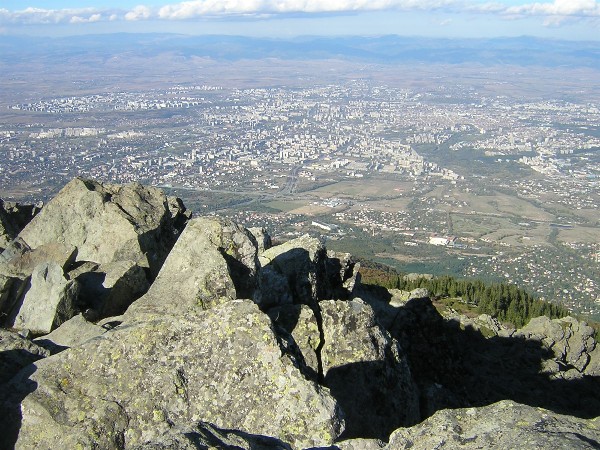
Sofia was already centuries old by the time the Romans came this way in the first century AD and renamed the place Serdica (the city was only named Sofia in the 11th or 12 century). Some traces of the Roman and Thracian (pre-Roman) city still remain. After the Romans went the city was periodically under the control of either the Byzantines or an independent Bulgarian State. Towards the end of the 14th century the city and most of the rest of the Balkans fell to the Ottoman Turks, and things stayed that way for more or less the next 500 years, with Sofia as a significant if quiet regional capital. In 1878 the Ottomans were kicked out for good, mainly thanks to the efforts of Russia, and Sofia was made the capital of a newly independent Bulgarian nation. Most of the modern city's buildings date from this time or after, but you'll find the odd considerably older building dotted around the city or its outskirts.
Things didn't really get much better for Sofia after Bulgarian independence; there were a string of unsuccessful Balkan wars in the late 19th/early 20th century, Bulgaria sided with Nazi Germany during World War 2 and suffered in bombing raids, and then 40 years of communist rule followed. The collapse of the economy after the fall of communism was just salt in the wound.
Still, things are getting better. The economy and political situation are more or less stable. And a large amount of money (much of it from the EU) has been poured into restoring and preserving some of the city's historic buildings.
The combination of Sofia's beautiful settings (up in the mountains, it's actually the highest capital city in Europe), a few millennia of history, and a young, vibrant and friendly population make the city perfect for at the very least a long weekend. Especially when you start to realise how cheap just about everything is out here...
Bulgaria is about as far from the UK as you can get and still be in Europe, which means that unless you’re a masochist if you’re going to Sofia direct you’ll want to fly.
From the UK you can fly direct to Sofia from Heathrow on British Airways. As they have the monopoly on this route they can, and do, charge whatever they want, and the price of a ticket can fluctuate dramatically. Our apex tickets bought a couple of months before travel set us back just over £170, and I doubt you’ll get a ticket for any cheaper than this. The flight time between Heathrow and Sofia is just short of 3 hours and it’s a perfectly pleasant flight, including some spectacular views as you fly over the Alps
The only other airline that flies direct between the UK and Sofia is Balkan Airlines, sometimes also known as Bulgarian Airlines, sometimes known as Balkan Bulgarian Airlines. This is the former state carrier of Bulgaria that has fallen on hard times (when I was Googling it I found links to stories about some of its hostesses offering to strip off for Playboy in a bid to stave off bankruptcy; sadly I was unable to find any pictures). Their UK website is here; you can’t book a flight online, you have to send them your details and they’ll ring you back with a price. It looks like you can book direct through this site though.
Other options from the UK include transfer flights (Lufthansa via Munich or Austrian via Vienna seem to offer the best connections). Or you could take a charter flight to one of Bulgaria’s Black Sea resorts, although these are some distance from Sofia
Sofia airport is small but seems to be pretty well organised. From Western Europe there are daily flights to and from Frankfurt, Milan, Munich, Paris, and Vienna, with less frequent flights from (among others) Amsterdam, Brussels, and Madrid, and weekly flights from Copenhagen, Lisbon, and Stockholm. If you’re flying in from Eastern Europe there are daily services from Athens, Budapest, Moscow, Prague and Warsaw, and a weekly flight to Bratislava. With the exception of a daily Istanbul flight, 3 flights a week to Tel Aviv and weekly flights to a few other Middle Eastern destinations (including Beirut, Damascus and Tripoli) no long-haul or inter-continental flights come in to Sofia. If you’re coming over from America or down under you’re going to have to transfer somewhere along the way.
Theoretically it is possible to get from London to Sofia by coach. The journey is a shade under 48 hours, and goes via Munich. When I checked on the internet I was quoted a price of £183 for a ticket. If you want to pay the same price for a 48 hour coach journey as you could pay for a direct flight on British Airways send me your email address and I will forward it to some Nigerian gentleman who have a variety of exciting business opportunities (using involving vast amounts of money stashed away in foreign bank accounts) that may be of interest to you.
If you’re not travelling quite so far Sofia has direct international coach services to, among others, Athens, Belgrade and Istanbul.
If you want to travel in comfort (although not necessarily more speed) there are direct train services between Sofia and (among others) Belgrade, Budapest, Istanbul, and Thessaloniki in Greece. Further afield you can also go direct to Moscow or St Petersburg.
With one big exception, which I’ll mention later, getting around Sofia is pretty straightforward. In common with most other cities in Eastern Europe Sofia is surrounded by pretty ugly post-war high-rise estates, but just about everything of interest in Sofia is within the relatively compact city centre so the only time you’ll see them is on your way from the airport and back.
The best way to get around central Sofia is on foot. The main hazards you’ll have to overcome are the poor state of many of the city’s pavements, and crossing the road; Sofia’s roads are busy and drivers tend to look on pedestrian crossings as a decoration rather than a traffic direction. Still, there are plenty of pedestrian subways and the Scotsman and I staggered around at all hours while completely hurrened and no harm befell us.
Sofia’s main street runs from north to south. It starts out being called Boulevard Knyaginya Mariya Luiza and runs past the train and bus stations into the city centre where it changes its name to Vitosha Boulevard and runs south past the Yuzhen Park in the direction of Mount Vitosha. Mount Vitosha, by the way, sits pretty much due south of the city and can be seen from anywhere on a clear day, which makes it a pretty useful aid to navigation. The Sveta Nedalya Church and the square that surrounds it is probably as close as central Sofia comes to have a focal point; hardly surprising as this has been the city’s main crossroads since Roman times. Trams 1 and 7 run between the railway station and Sveta Nedalya. The Largo runs west off Maria Luiza Boulevard and merges into Boulevard Tsar Osvoboditel, which will take you to some of Sofia’s most significant buildings, including the Russian Church and the Alexander Nevsky Church. A lot of embassies and Government buildings are around there too. Many of the streets in this area have distinctive “golden” cobblestones, so if you get lost it really is a case of “follow the yellow brick road”, it’ll usually lead you to a bar.
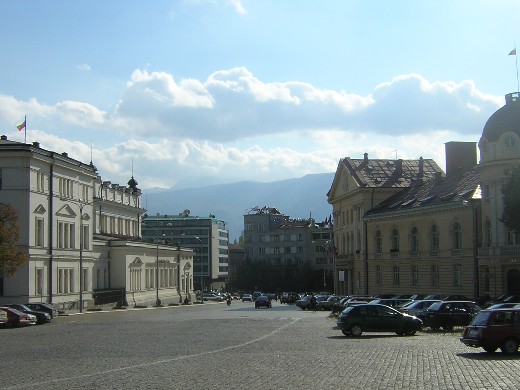
Traffic in Sofia seems to be pretty disorganised with the result that it gets quickly congested (and noisy). There are comparatively fewer cars than you’d get in major cities in Western Europe, but the roads are narrower, in a much worse state, have tram lines running along them and, difficult as this may be to believe, the standard of driving seems to be much worse. Basically, I wouldn’t want to even consider driving in Sofia, although the city’s many taxi drivers seem to cope pretty well. More on them later.
Right then, this is Eastern Europe so you know the drill by now, cheap, widespread and reasonably efficient public transport system, blah blah blah.
Sofia has its own underground system. Actually, “system” is probably a bit of an exaggeration as there’s only one line; it heads out towards the housing estates west of the city where there’s nothing of any interest for tourists, so it’s almost exclusively used by workers commuting into and out of the city centre. Of more use are the networks of trams, trolley buses and buses. As in most other places in Europe you should buy your ticket before you get on (most kiosks sell them) and then punch the ticket when you get on to validate it. As usual under cover ticket inspectors are on the prowl; the cost of a ticket is so cheap and the fine so big in comparison that it’s really not worth the bother of trying to travel without one. Daily and weekly tickets can also be bought from kiosks. One thing to remember that if you’re travelling with bulky baggage you’re supposed to get a separate ticket for it. There are also privately run minibuses which have no connection with the official public transport system; you have to buy tickets for these from the driver.
If you’re going a bit further afield, or coming back early in the morning after the public transport has shut down (most of the network closes before midnight but it reopens again around 4am so if you really need to take tram my advice would be to stay out on the piss all night until they start running again) then you’re probably looking at a taxi ride. Now I’ve said some pretty disparaging things about taxi drivers elsewhere on this site but I’ve got to say that the ones in Sofia are, well, sort of OK. Not great, or outstanding, but definitely OK. Taxis are surprisingly cheap in Sofia, and by law all taxis must run on a meter and display the meter rates clearly. The problem is that rates vary wildly but generally speaking if you pick up one directly outside hotel you’re going to be paying more (we took a taxi to Dragalevtsi and it cost us three times more to get there in a taxi that we caught outside our hotel than it did to come back in a taxi we hailed in the street). I would advise you to check the tariff but as it’s almost certainly going to be written in Cyrillic that might be a bit tricky. But, generally speaking, we found Sofia’s taxi drivers to be a pretty friendly bunch, hopping around the city in a taxi for a few days isn’t going to break the bank, and they have my undying admiration for coping with the traffic in the city centre.
Sofia Airport is about 7 miles east of the city centre. Coming in to the airport it’s a pretty impressive descent, surrounded by hills with Mount Vitosha towering up on one side. The number 84 bus runs from the airport but terminates near the main University building which would be a bit of a hike from the city centre if you’re carrying luggage. The lazier among you will probably opt to do what we did and take a taxi in the airport. You can either go outside the terminal building and take a metered cab or negotiate a price in advance with one of the many semi-legal (actually, I think they’re totally illegal) taxi touts who hang around the airport. I think that we negotiated a price of 20 leva, which was probably on the expensive side, but we ended up paying him in pounds (£10, if I remember rightly, which was even more on the expensive side). It took us about 10 minutes to reach the city centre and then another 20 to work through the congestion to our hotel.
There are a few places of interest away from the city centre; the National History Museum is in the suburb of Boyana, southwest of the city centre on the slopes of Mount Vitosha. And if you want to head up Mount Vitosha itself the best places to head to are the villages of Dragalevtsi or Simeonovo. All of these can be reached by public transport from the city centre but to be honest, unless you’re really skint (or cheap) you’d probably be better off taking a taxi.
OK then, back to that big exception I mentioned back at the start. Getting around Sofia is pretty straightforward with the exception of the bastard Cyrillic alphabet. All street signs and road signs are in Cyrillic. All public transport maps and timetables are in Cyrillic. All signs on the front of buses and trams are in Cyrillic. And all the street maps that we had weren’t in Cyrillic. Fair enough, it’s their country, they can use whatever alphabet they like. Once you’ve got your bearings you should be fine, but until you’ve got your bearings you’re going to be relying on street names and signs and unless you’ve got some familiarity with the Cyrillic alphabet this might cause you some problems. The differences between the Cyrillic and Roman alphabets make it hard to even make an educated guess at what a street sign really says. After a few days we were starting to get the hang of it but if you’re planning a trip to Bulgaria it’s definitely worth sitting down and trying to learn even just the basics of the Cyrillic alphabet. I’ve managed to do it, and if I can do it anyone can, and it only took me a couple of hours, but sadly I decided to do it after I’d got back from Sofia. D’oh!
We stayed in the Sun Hotel, which we booked through HotelsBulgaria. It's an excellent hotel, and I recommend it highly. The location is good, if a little noisy and slightly seedy, on Maria Louisa Boulevard, right next to the Lion Bridge, which means that in one direction it's a 5 minute walk to the train station and in the other direction you'll reach the Sveta Nedelya Church and Sheraton Hotel in 10 minutes. The hotel is small and is in quite an old building, but it has recently been refurbished. Our room, which overlooked the main road (they did offer us a choice of rooms when we checked in) was clean and came with a reasonably priced mini-bar and TV (although they only had local channels). Special mention must be made of the shower, one of the most powerful I've experienced. Luckily the bathroom floor drains quickly. Special mention must also be made of the staff, who spoke English, were helpful and extremely friendly, looking on with increasing amusement as we staggered back in at past 6 every morning, spectacularly failing to make it down for breakfast even once, and finally bursting out laughing the time I dragged myself back home at quarter to ten (in the morning) still rather the worse for wear. There's also a security guard on duty in the lobby at all times, but his main job seems to switching the lights on the stairs on when guests come down. The total cost for four nights was £154, an absolute bargain.
When we went back in August we were recognised from our previous visit; they obviously remembered that we were men of leisure who rarely stirred before midday and so gave us a room around the back of the hotel on the grounds that it was away from the main street and so quieter and therefore less likely to interrupt our sleep (after staying out on the piss in Caramba until 4am I doubt that anything short of an al quaida attack would interrupt my kip). The room they put us in was quieter but a hell of a lot smaller. It didn't have a bath either, just a shower attachment with a drain the toilet floor.
Breakfast was included in that price, but as I said, I never even got close to making it down on time so I can't tell you anything about that. According to my chimp-like friend who did manage to make it once or twice it's a rather nondescript selection of bread, cold meat and cheese, so it doesn't sound like I missed too much. There's also a piano bar on the ground floor, which is a pleasant enough place; they only served bottled beer but it's cheap enough (even after they drop it, which happened to us), as is the coffee. They have a canary in there too.
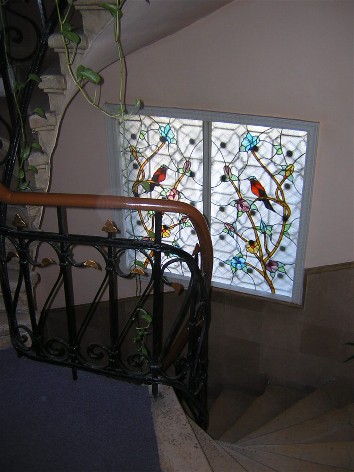
.
Eating and drinking in Sofia is a remarkably cheap experience. Even in a decent bar or restaurant a half litre of local beer will set you back around 35 to 40p. A good pizza will set you back all of around £2, and most meals come in the £3 to £4 bracket. During our stay we didn't pay more than around £8 each for a meal, and that included beer and a couple of bottles of wine. What follows is a selection of places that we tried. Every restaurant we went had had a translated English menu (although we usually had to ask for it), every bar and restaurant we tried had English speaking staff.
We started off with a visit the Svejk Pub, which is tucked away under a shopping centre on Vitosha Boulevard (on the same side of the road as the Sheraton Hotel, but just a bit further south). If you're really struggling to find it keep an out for Svejk himself (basically an old geezer with a big mustache and old military uniform, dressed up as Svejk from Jaroslav Hasek's novel "The Good Soldier Svejk"); he can often be found in Vitosha Boulevard directing people inside. And you thought your job was easy....Anyway the pub itself is a dark but spacious underground drinking hall, better known for the wide range of beers it offers, but it has a pretty extensive menu as well. The Scotsman went for the trout (whole, fried) which came with spiced potato wedges, while I went for the shashnik, basically a kebab of huge chunks of grilled chicken and pork. Both were excellent, as was the starter, a shopska salad (salad with fresh grated sheep's cheese).
Still stuffed from the shashnik we thought it would be a good idea to go for a lighter meal later that day, and so we ended up in Pizza Palace, also on Vitosha at number 34. The pizzas were very good and cheap, although some of the toppings available were a bit eccentric (peas on a pizza?!?). And for some reason the waitress saw fit to talk me out of ordering the seafood pizza I originally ordered. She also seemed surprised when we ordered both beer and wine at the same time, maybe they don't get many Brits in there. The wine (Bulgarian mavrud) was very drinkable and cheap too.
Pizza Troll is a chain of pizza restaurants (well, it's hardly likely to be a Thai restaurant with a name like that...). We ended up in the one on Ploshtad Slaveikov (which is on Ulitsa Graf Ignatiev, opposite all the book stalls). The art nouveau decor was interesting, but I'm not sure what it had to do with either pizzas or trolls. The same goes for the big fish tank.... The tables were unusually high as well, even big bastards like us ended up eating with our elbows around our ears. There were a few strange things on the menu; possible pizza toppings included carrots, pickles, and oranges (not on the same pizza though). They also have "English breakfast"; eggs and bacon are present and correct, but I can't say I've ever seen an English breakfast that includes cucumber before. I can't remember what I had now, but it was something a little more conventional, and very nice it was too. The beer was good and cheap as well, and we lingered for a few.
I can't remember how we ended up in Club Restaurant Parchevich, on Parchevich, east just off Vitosha Boulevard. I think we'd been wondering round for a while and just decided to go for the next place we saw. It's a decent enough place though, quite classy with good service. The shopska salad was again excellent, I went for a pepper steak and chips, which was good although it could have done with being a bit more peppery, and the Scotsman tried a huge plate of caviar and blinis, I had a sample of that and it was fine. Top value for money (the caviar cost less than £4), and as an added bonus we were able to watch the football results on teletext (Oldham won!).
Right, for reasons that might involve large amounts of wine I can't actually remember the name of the next place we tried, but it's a fish restaurant on Denkoglu (west, off Vitosha Boulevard). You really can't miss it though, as it has a huge sign of a fish outside, and it's been done out in wood to look like the back of some kind of galleon. I'm pretty sure that it's the only building like that on Denkoglu. The nautical theme continues inside, with stuffed fish and model sailboats hanging from the roof. There are three big fish tanks down one side too, although I'm pretty sure that the tropical fish inside aren't on the menu. Then again, for all I know they might have been. Although the menu is in English the translation was somewhat poetic. Basically we didn't have a clue what anything on the menu was ("Sea Crow", anybody?) and so ended up ordering at random. The Scotsman ended up with one big fish, I got three medium sized ones, all served up fried and whole. Whatever it was I had it had a nice, delicate flavour, although picking out all the bones was a bit of a pain. Being philistines we ordered red wine with our fish; the mavrud was again superb, but its rich flavour was perhaps a bit too powerful for the fish. Oh well, you live and learn. Again, the service here was quick and friendly, and the value for money was remarkable (we had to double check the bill to see if they'd missed anything off). Well worth trying out if you want a change from meat.
Background, at 14 Vitosha Boulevard was a pleasant place, with an outdoor courtyard. They have a pretty extensive menu, with an English translations and rather unappetising photographs of all the dishes. The Scotsman opened up with an amazing salad of grilled vegetables (aubergine, peppers and tomatoes, among other things, I think it was called a maranara salad), while I enjoyed my chicken noodle soup. For the main course I had a pork steak in a cream, ham and mushroom sauce. The pork was a little tough and overcooked. The Scotsman had some strange vegetarian thing, eggs, bread and other vegetarian things fried in a batter. He recommends it though. Yet again the waiter was really helpful and friendly; yet again it was all unbelievably cheap. The only downside was the lack of Bulgarian beer on draft, I had to settle for an Amstel, but you can't have everything.
We went in O! Shipka (at ullica Shipka 11) in search of pizza, and we weren't disappointed. It's a sprawling, popular place with a big outdoor terrace around the back. They had a wide range of strangely named pizzas, all of which were dirt-cheap (less than £2). For reasons that might have involved an over-indulgence of the fruit of the grain and grape the night before I was unable to finish my smoked chicken pizza, but what I did eat tasted good, and they cook them pretty quickly too. Good, cheap beer is a bonus too.
Next door to O! Shipka is The Witches. It looked interesting when we passed it after coming out of O! Shipka so we went back later the same day, and it turned out to be a good choice. The general witch theme (basically lots of broomsticks) is a bit off-putting, but the food was top notch. Apparently they're best known for their huge dishes of paella so bearing this in mind I went for the steak and the Scotsman had mackerel. My steak was superb, cooked to perfection (nice and pink) and full of flavour, one of the finest steaks I've ever had. The Scotsman's mackerel came whole and grilled and was polished off quickly and rated as very good. The couple of bottles of Bulgarian melnik wine we washed it all down with went down a treat too. Needless to say the service was great, and the price was incredibly low. They have a pleasant little terrace at the front where you can sit outside in the summer. We were sitting there in August when it started to rain; almost immediately the waitress insisted that we moved inside. We were a bit reluctant as being Brits we were hardly strangers to the rain, and we'd also had a few by this stage and so thought it would be fun to sit out in the wet (we were under a big umbrella in any case). Anyway, the waitress was insistent and once we were inside we could see why when within about 5 minutes lightning started fizzing round, apparently within touching distance, and within about half an hour the terrace was under 3 or 4 inches of water. Naturally, we thought it would be a good idea to stay inside for a few hours, just until the rain had stopped...
As you might imagine, the Peter I Russian Restaurant on Pozitano (just south of the Sveta Nedelya church) serves Russian food. The prices are above average for Sofia, but they serve big manly portions. It's a huge underground cellar with a classy atmosphere, and even though it was practically empty when we were there I'm told that a reservation is usually required. I started off with the borsch and then went for the peasant style beefsteak (basically a huge lump of minced beef with spuds and onions), while my monkey-like friend had some big grilled chicken thing that was served on a kebab and came with rice, oranges and apples. They had a rather good wine list too, I think we went for a bottle of the Bulgarian melnik. They sometimes have live music.
Captain Cook at 12-14 Pencho Slaveikov Boulevard is a very classy fish restaurant, which also has little aquariums full of exotic fish. The tuna and shark were both excellent, I ordered the paella and ended up with a deep plate of the stuff the size of a dustbin lid. It was lovely but in a pathetic effort I could only put away less than half of it. Again, it's above average prices but the food here is definitely worth paying that bit extra for.
I can't remember why we decided to try Rio, on Bulgaria Square (south of the city centre, somewhere near the Palace of Culture), a Brazilian restaurant of all things! Actually I can remember why, but I'm not going to tell you... It's got plenty of decoration, including an indoor stream and water fall, but the overall theme seemed more Aztec than Brazilian. They also had a big aquarium, for some reason. Strange... The food errs on the meaty side. We were tempted by the "all you can eat" barbeque. The waiter explained to us that if we ordered this they'd just keep bringing us meat and chicken (and salad - as if!!) until we could take no more. We didn't feel it was fair to bankrupt them in this way and so just ordered of the normal menu. Both of us had smoked meat (worryingly it wasn't specified what type of meat) which came with rice and beans and fruit, all on the same plate. It was fine, and there was plenty of it, but it was nothing outstanding, and this was the most expensive meal we had in Sofia (still less than £15 a head, including wine). Maybe we should have gone for the all-you-can-eat option after all.... The service was excellent though. Apparently this place is popular with visiting businessmen (on expenses), and reservations are normally needed, although we were there on a Sunday night and it was dead.
The House, at 4 Verila (off Vitosha Boulevard) serves Bulgarian food. It gets its name because it is basically a house with a restaurant in it, it's all divided up into little rooms, I think we ended up eating in what was once somebody's bedroom. Being a Bulgarian restaurant they have one or two oddities on the menu, like tripe soup, lamb's balls (yes, those kind of balls), and boiled brains (which have a sort of sea-food taste but a weird texture). We stuck to the more mainstream areas of the menu; I had a steak with some strange three-flavoured sauce, which was very good despite my loss of appetite which may or may not have had something to do with staying out on the piss until 10am the night before. The fried foie gras was impressive too. They also have a wide selection of cigars, mainly genuine Cuban ones. I thought that this would be a good way to finish off the meal (well, I'd had quite a few by that stage....). It was a very nice cigar (Romeo y Julieta) but it cost around the same as both our meals and booze combined. A touch of indulgence is good for you every now and again. Very helpful service, a good wine selection (I think we had the traminer) and very reasonable prices mean this is a place we'll return to.
We ended up in the Happy Bar and Grill a few times, mainly because it was so conveniently located (just over the road from the Sveta Nedelya Church). It's a fast food restaurant that manages the unusual trick of serving "fast" food that is both slow and cold. The strawberry milkshakes are an excellent hang-over cure though, and the waitresses wear incredibly short skirts...
OK then, onto bars. Opening hours are pretty civilised, basically at the discretion of the owner. Just about everywhere stays open until midnight, most places a few hours longer than that, if you want somewhere to toast the rising sun through the bottom of a beer glass you'll find it without too much effort, and there are even a handful of non-stop 24 bars dotted around.
Lucianos was recommended to us by a friend. It's not the easiest place to find, tucked away in a little courtyard off Ulitsa Graf Ignatiev (opposite all the book stalls). It's well worth seeking out though, a spacious if smoky cellar bar which was packed to the rafters while we were there. They have a wide range of Bulgarian and imported beers on draft (around 70p for a litre), and an even vaster selection of bottled stuff. They have a wide selection of food, mainly bar snacks, that seemed to be very popular but we stuck to our liquid diet, for the protein. My favourite touch was that everything on the menu was also photographed, meaning that about half the menu was taken up by photos of glasses of beer of differing varieties and sizes. I know that this almost certainly to help out confused tourists, but a part of me takes comfort from knowing that it also helps the pissed up who are too paralytic to ask for a beer to simply point at what they want. A quality establishment.
From its name you'd probably guess that JJ Murphys on Karnigrdska was in Irish pub, and you wouldn't be wrong. Then again, there aren't that many Irish pubs around the world festooned with Union Jack flags and the cross of St George. This was actually my third trip on the trot where I've ended up in an Irish bar, a bit of a worrying development, but at least we had an excuse this time; we wanted to watch the Turkey vs England football match and figured that this would be a good place to watch it. We weren't disappointed. "Bravest Man of the Night" award must go to the Scotsman for loudly cheering on Turkey while surrounded by a pub full of English football fans, in the middle of a city not exactly noted for its love of the Turk. Still, he made it out alive. Things I liked about this place included its atmosphere which was very lively. That may have had something to do with the football, but judging by the photos of hurrened regulars on the walls it's regularly like this. The staff were friendly and helpful too. Things I didn't like were that they didn't serve Bulgarian beer, only imported stuff (Heineken and Murphys), for which they charge around twice the price of other bars in Sofia (4 leva a pint). They also do food here, but the menu (and food we saw) didn't look that inspired so we didn't try it.
Allow me now to give a huge plug to bar that I can't remember the name of. I know where it is though, at the junction of Aksakov and Vasil Levski, on the opposite side of a crossroads from the University building. It has a "Skii" advert on it if that helps. The Scotsman and I staggered past here at about 1am in search of another bar. We stopped outside here to check our map, and despite being closed the barman/owner came out to offer us directions. Things got a little complicated so he invited us inside, opened up the bar for us, and then managed to work out exactly where we were supposed to be going while we knocked back a pint. He told us that he was sleeping in his bar that night as he was too pissed to drive home. The man is a star, go and shower him with riches!
The place we were actually looking for when we chanced upon that good samaritan was actually Caramba. To make things easy I can tell you exactly where it is, it's in the basement of the Hotel Bulgaria on Tsar Osvoboditel Boulevard. It's actually more of a nightclub than a bar, and there's a cover charge to get in (only 2 leva), and occasionally a queue. This is a fine place, and was packed out every time we went in. They play mostly Latin music (as in Latin American, not Roman), and play it loud. The beer situation is a little disappointing, they only have bottled, and nothing Bulgarian, and it's expensive (3 to 4 leva a bottle). The staff seem to find it very funny if you're swigging from more than one bottle at time (when it's busy the service can be a little slow, so it's a good idea to order in bulk so you have a few in reserve). The genius of this place is in the manner that the beer reaches you; they have stages running around the place, there's waitress service, the waitresses are rather scantily clad, they bring the beer along the stage, and when they're not bringing beer back and forth they dance. Genius. Don't let that description mislead you though, there's nothing indecent going on, this is not some kind of seedy lap-dancing place (as if the Scotsman and I would ever be caught in such an establishment!), just a lively bar that's very popular with both sexes (they have dancing men on the stages too as well as a small dance floor). So popular that they not only have reserved signs on the tables but they have them along the bar as well. By the way, apparently they do actually have strippers (of both sexes; my friend was treated to the spectacle of both a stripping Superman and a stripping Elvis, and we both saw one who we couldn't decide was meant to be the Terminator or Keanu Reeves in The Matrix) in this place, although they only came on after I left (honest, mum). Monday night is the night for naked female flesh, or so I'm told. And be warned that you have to pay the attendant to use the toilets in here (0.2 levs). Piss on the floor instead, that'll teach them.
Another nightclub that's more or less in this neck of the woods is Bibliotekata, which you'll find in the basement of the national library on Oborishte (off Vasil Levksi), of all places. This is quite a classy establishment, as you can tell from the security check when you come in (one of those airport metal detector arches; they let me in even though I beeped), sophisticated furniture and decoration (the toilets have to been seen to be believed, I felt almost guilty about soiling the urinals), and the attached Sushi restaurants. Unfortunately it was so classy that they didn't have any customers; I'd say that there were less than 10 people in there, including the Scotsman and myself, although that was at 11 on a Monday night, maybe it got livelier later on. If not, if you're looking for a nightclub where you can have a quiet reflective pint, and piss like a King, this could be just the ticket.
For various reasons we ended up spending a fair bit of time in the piano bar of the Sun Hotel. As hotel bars go it's actually pretty pleasant; you'll often hear live music (either piano, as you might guess from its name, or classical guitar). It doesn't stay open until very late, and they only have bottled beer, but it's pretty cheap. The service is very friendly but endearingly amateurish; the waitress ended up dropping the first two beers we ordered in there. They don't seem to be used to British ways of drinking either (and I think that this is true for most of Sofia). One evening my chimp-like companion decided he was going to have a snooze before we went out on the piss. Being made of sterner stuff I thought I'd leave him to it and spend some time in the piano bar, it being a good opportunity to write my postcards and catch up on some reading ("Evil Spirits", a biography of Ollie Reed, highly recommended). Naturally I thought a few beers would help the time pass a little more convivially. The waitress got increasingly more surprised very time I ordered another beer, and when I left to awake the sleeping beauty upstairs after 6 bottles or so in the space of an hour and a half (not an especially excessive volume or rate) she asked me if I was going to be sick! It was probably a good thing that she didn't know that I'd already had a fair few during the course of the day before I even started there, or that she didn't see what state we were in when we staggered back to the hotel at 5am. They definitely need to get used to serving Brits....
The Church of Sveta Nedelya is probably as close as you can get to the heart of Sofia, standing where Maria Louisa Boulevard becomes Vitosha Boulevard, so it seems a good enough place to start off. The current building dates from the mid-19th century, but a church has stood on this site (the major crossroads of Roman Serdica as well as modern Sofia) for centuries.
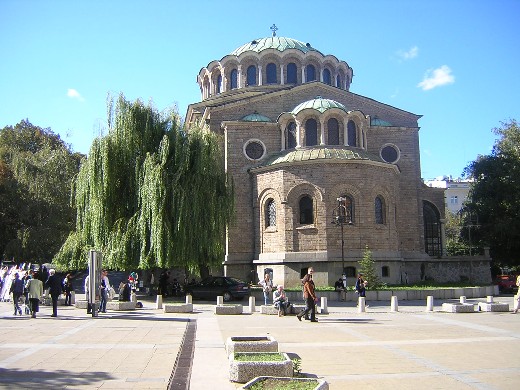
It's an attractive building, a typical Orthodox design involving lots of domes, and looks impressive when illuminated at night, when it makes a good land mark as you can see it from along way away on Vitosha and Maria Louisa Boulevards. Inside is pretty impressive too, all the walls and the inside of the main dome are covered in frescoes, although the light is a little dim and the paintings a bit too dull to make every detail out. Big areas of the frescoes are also badly damaged, apparently by water leaking in. There's also a nice looking gold screen, studded with icons.
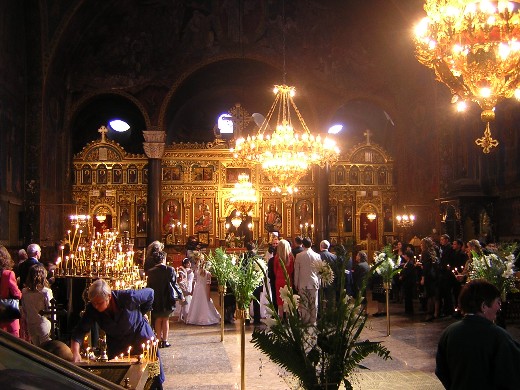
In 1925 a huge bomb was detonated inside the church in an unsuccessful attempt to assassinate the then-King of Bulgaria, Tsar Boris. The bomb did successfully manage to kill well over 100 other people though, including many Government Ministers. Nowadays the church seems to be Sofia's most popular wedding venue, it seemed that every time we went past another wedding party was coming out.
From the church you have a choice of directions, north up Boulevard Knyaginya Maria Louisa or south down Vitosha Boulevard.
Vitosha Boulevard is one of the city's main commercial streets, and it's here that you'll find Sofia's poshest shops (including a few western chains). There are also quite a few bars and restaurants, but there's nothing really of any historical significance, or of interest to tourists (unless you want to go shopping, or get something to eat....). Vitosha Boulevard is the way to go to reach Mount Vitosha, but I'll come to that later. If you're after a bit of culture Vitosha also takes you to the National Palace of Culture, a modern building which I'll charitably describe as "distinctive". It stands in one of Sofia's many city parks, Yuzhen Park, and is the city's main venue for concerts and exhibitions. Apparently if you're after a counterfeit football shirt, the market stalls in its basement are the place to go.
Maria Louisa Boulevard is also a busy commercial street, although the shops are not quite as up-market as those on Vitosha, with the exception of TZUM Shopping Centre, a collection of small shops and stalls housed in the former Communist general department store. Maria Louisa Boulevard also has plenty of bars, restaurants, casinos and hotels. It is a lot more run-down and seedy than Vitosha, but is lined with more interesting buildings, especially as you approach the Lion Bridge (Most Lavov).
Just north of the Sveta Nedalya church Maria Louisa Boulevard reaches a crossroads, with The Largo to the east. The big statue looking over the crossroads represents Sofia (or "wisdom", from where the name Sofia derives), and replaced the huge statue of Lenin that used to stand here. This is a very busy junction, hence the pedestrian underpasses, which also give access to one of the stations on Sofia's Metro system. In common with many other pedestrian underpasses in this part of Europe this one is lined with small shops, most of them hawking an impressive array of tourist tat, and there's also a casino down there. At the very centre though, basically an underground traffic island in the middle of the crossroads, is something far more interesting, the Church of Sveta Petka Samardzhiiska (Church of St Peter of the Saddlers).
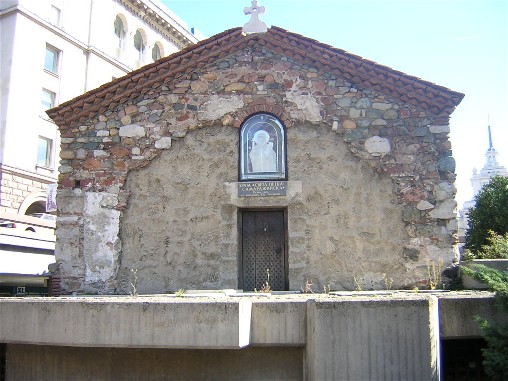
This tiny stone church owes its present innocuous position to the fact that under the (Muslim) Ottomans Christian churches were only tolerated if they were built underground. The current building dates from the 14th century, but it's built on Roman foundations, bits of which can be seen (as well as early Christian tombs) in the church's lower level. The upper level of the church is covered with colourful fragments of restored frescoes some of which date from the 15th century. Entry to the church costs 5 leva.

Probably the most significant building on Maria Louisa is the Banya Bashi Mosque, a graceful, understated building with its single dome and one slender minaret (which makes a good navigation aid for the lost or drunk when they light it up at night).
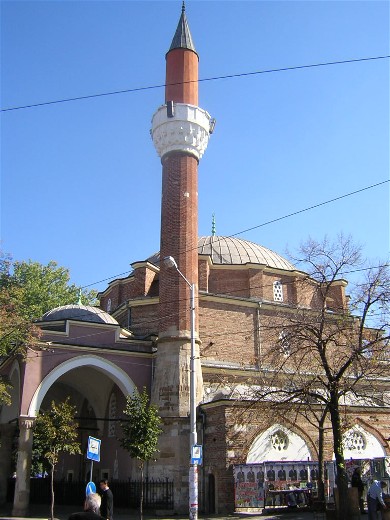
The mosque was built in 1576, and is the last in Sofia still in active use. You're allowed inside, but you must take your shoes off before entering. The Scotsman and I decided that removing our shoes in there would be so offensive that it could be construed as inciting religious hatred and so we stayed outside.
The ornate looking building to the east of the mosque is the public baths, also known as the Turkish Baths or the Mineral Baths. The baths, which were abandoned for many years, are now undergoing a lengthy and expensive EU-funded restoration and it is planned that it will hold a City History Museum when restoration is finished. On the opposite side of the street to the mosque is the Halite, an attractive early 20th century Art Nouveau-ish food market, recently renovated and re-opened as a market.
Keep heading up Maria Louisa Boulevard as far as the Lion Bridge (Lavov most) which doesn't quite live up to its grand name, but in fairness at least it does have some statues of lions on it. Keep going if you want to go to the railway station, but there's not much else to see in this direction. Rather than double back down Maria Louisa Boulevard head a block to the west and then go south down George Washington. This is mainly a residential street with a few cheap shops, even more run-down than Maria Louisa, but there are a couple of things to see down here. First of all is the pretty yellow and white striped Church of Sts. Cyrill and Methodus (SS Kiril i Metodii), the gardens of which seem to provide a haven a tranquillity for local residents.
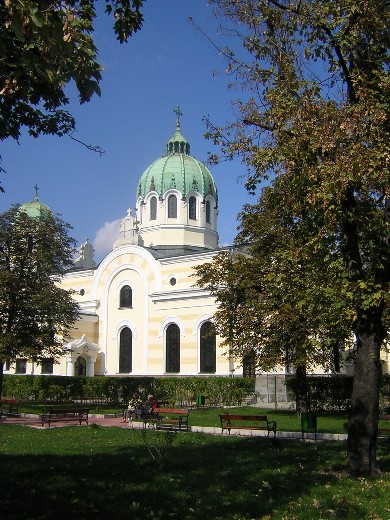
Keep going south on George Washington and at its junction Ekzarh Yosif with you'll find another of Sofia's religious buildings, the Synagogue. This huge building dates from the early 20th century, and is the last in the city still in use (Sofia's large pre-War Jewish population survived the more or less intact, even though Bulgaria was an ally of the Nazis, but most subsequently elect to decamp to Israel). As such it's not usual open to visitors (apart from Jewish ones, obviously) but the exquisitely decorated exterior makes it well worth a look.
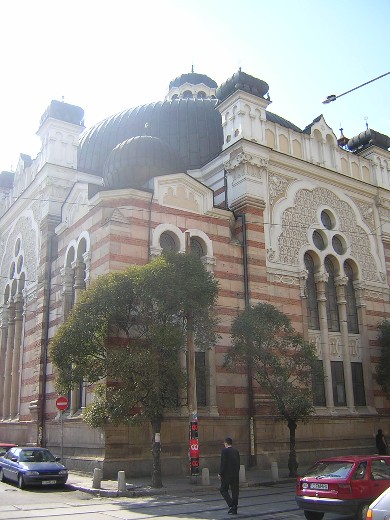
Off the top of my head I can't think of too many other cities where you have a church, a mosque, and a synagogue (and a casino, if you want to add the worship of money) within 2 minute's walk of each other.
From the synagogue head south for a couple of blocks and you’ll find yourself back at the traffic junction with the church of Sv Petka Samardzhiiska in the middle. On the opposite side of the crossroads is “The Largo”; it has an impressive name but it’s basically a narrow expanse of green surrounded by car parks and busy roads (it’s the result of “urban clearance” created by Allied bombing raids during World War 2).
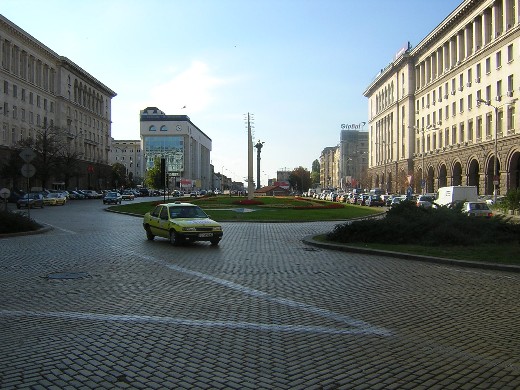
The yellow cobblestones (optimistically described as gold is some tourist brochures) by the way run from the Largo, through Ploshtad Aleksandar Batenburg and then down the length of Bulevard Tsar Osvoboditel, were a gift from the Austrian Emperor at the beginning of the 20th century. Very considerate of him, I suppose they didn’t have Marks & Spencer vouchers back then.
The Largo is surrounded by grand, if not especially attractive post-war buildings. On the north side is The Council of Ministers, home to Bulgaria’s cabinet, at the eastern end is the Party House, previously the official HQ of the communist party but now to offices for Bulgaria’s Members of Parliament. On the south side is the sprawling Hotel Balkan Sheraton. This is worth further exploration as round the back (actually nestled between two wings of the hotel is one of Sofia’s oldest buildings, the Rotunda of Sveti Georgi (Rotunda of St George). This tiny brick-built basilica has been here since the 4th century although it has been rebuilt and restored a few times since (hence the big concrete slabs holding it together).
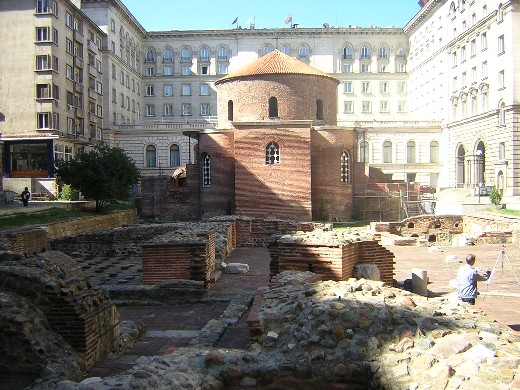
Inside the interior of the dome is covered in frescoes, again they have been restored a few times but as they mostly date from the 10th to 14th centuries they’re in amazing condition, with still-vibrant colours and expressive faces. This is definitely one of the unmissable attractions of Sofia
To the east of the rotunda is a large area of excavated archaeological remains that you’re free to wonder around. No one seems to be exactly sure what they are, but they’re believed to be remains of the Roman city.
From here go through the passageway furthest to the east of the rotunda and all the archaeological stuff, which brings you out in an attractive square at the western end of Ploshtad Aleksandar Batenburg. As you come through the passageway the building immediately on your left is the Presidency, home to Bulgaria’s President. The two men standing outside it in silly uniforms are his guards; perhaps they intend to tickle potential assassins to death with their ridiculous feathered hats. Apparently the changing of the guard ceremony, which takes place on the hour, is worth hanging around for.
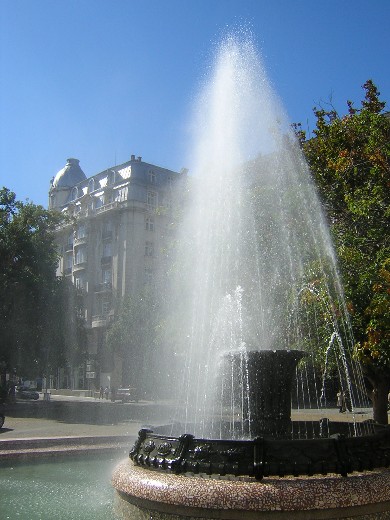
The fountain, by the way, is the ideal spot for a cooling and refreshing dip after you've staggered out from a sweaty night of debauchery in the nearby Caramba bar. Remember though that if you do fancy a midnight (or 4am) paddle, followed by a mile's stroll back to your hotel while wearing only your boxer shorts, for God's sake don't try it in winter or you'll freeze your balls off.
The attractive building on the opposite side of the fountain is the National Archaeological Museum, housed in what used to be the 15th century Great Mosque. There's a wide range of stuff on display from Sofia and the rest of Bulgaria, ranging from prehistory through to medieval church paintings. The Thracian and Roman sections are particularly extensive. Possibly the strangest exhibit is a fragment of pottery labelled as neolithic and patterned with what can only be described as swastikas. You'll be pleased to know that everything is clearly labelled in both Bulgarian and English (unless you're French...). The museum has far too many exhibits to display them all at once so some of the bigger ones have been left outside in the front garden, or in the outdoor café round the back of the building. Entry to the museum is 5 leva, and it's well worth a look.
If this puts you in the mood for a bit more archaeology then you’re in luck. You’ll find it in, of all places, the pedestrian subway in front of the Presidency; down there are the preserved foundations of the main eastern gate of the Roman city of Serdica (as well as few touristy tat shops).
On the south side of Alexandar Batenburg is the grandly-named City Garden, probably the most popular of Sofia's city centre parks. The park houses, among other things, some surprisingly peaceful and shady gardens, a big fountain, a display detailing, for some obscure reason, the reconstruction of Beirut, and the Ivan Vazov National Theatre. The theatre, built in 1907 and designed by the same firm of architects responsible for national theatres in, among other places, Bratislava and Prague, is an attractive pink and white neo-classical building, with bits of gold trim. It would probably be even more attractive without the huge cinema screen that was hung from the front of it last time I was there (they probably only do this in winter). I've no idea what films they show, but I doubt it's anything dodgy (a shame; showing Shaving Private Ryan on a screen that big would surely be some kind of record).
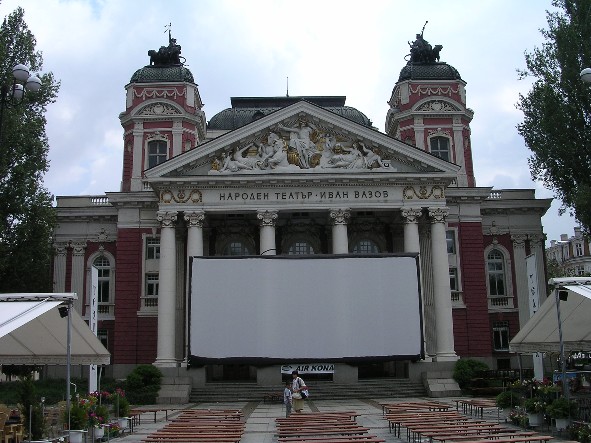
During the summer the whole courtyard in front of the theatre becomes a vast series of outdoor bars and cafes. There's probably no better place in the city to kick back with a beer or four and just watch life go by for a few hours. Although doing it for 4 days on the trot like we did might be considered a bit lazy....
From Alexandar Batenburg you can follow the yellow brick road east, where it becomes Bulevard Tsar Osvoboditel. As well as running through several of Sofia’s city centre parks, this road has a few buildings of interest on it, the first of which you’ll pass is the yellow National Art Gallery, housed in what used to be the Royal Palace (and before that the home of the Ottoman Governor). There’s nothing outstanding or by anyone famous (outside of Bulgaria) in here so it might be one to save for a rainy afternoon. Housed in the same building, and possibly of more interest, is the Ethnographic Museum. If you’re still in a museum mood you can complete the hat trick by going for the Natural Science Museum which is next door; they have lots of animals, a few of which are still alive but most of them are either stuffed, pickled, or skeletonised (is that a word?!?). There are rocks here too.
The next building along Tsar Osvoboditel is perhaps the most attractive in Sofia, the Russian Church of St Nikolai, built at the beginning of the 20th century by a home sick Tsarist diplomat, worried about what awaited him in the afterlife if he prayed in a Bulgarian Orthodox Church. The exterior is stunning, from the porch (complete with mosaic) to the five onion domes (covered in real gold leaf, which is probably why so many gypsy beggars hang around outside it; maybe they weren’t asking us for money after all, maybe they just wanted a ladder). The interior is worth a look too, covered in rather dark frescoes and icons but we spent more time admiring the outside, trying to figure out a way on to the roof.... If you go down into the crypt you'll find the tomb of some former archbishop; apparently if you write your wish down on a piece of paper and leave it by his tomb then it'll come true. Complete bollocks of course; the gold is still on the roof and Kylie Minogue still hasn't called me....
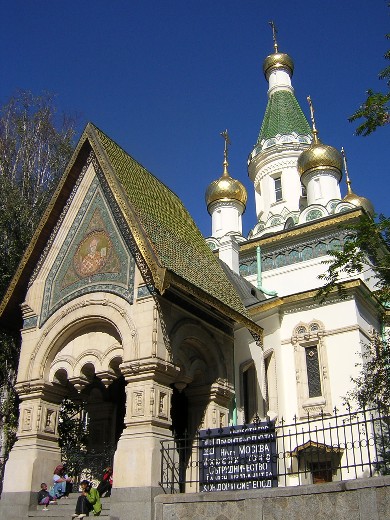
You can keep heading east down Tsar Osvoboditel. Standing in front of the Radissson SAS hotel is a statue of “Tsar Osvoboditel” himself, on horseback, or Tsar Alexander II of Russia as he’s better known (“Osvoboditel” means “Liberator”; it was Alexander who kicked the Turks out of the Balkans). On the opposite side of the street to the statue is the National Assembly building, home to Bulgaria’s parliament.
At the end of Tsar Osvoboditel is the main building of Sofia University. Turn left (north) here, up Bulevard Levski. The first building on your right after the University is the National Library. The statues outside it are of Sts Cyril and Methodius, devisors of the infernal Cyrillic alphabet, so they’re the buggers to blame for why you’ve been getting lost so often. I can’t think of many other National Libraries that have a night club in the basement (see the “Where to Get Drunk” section). It’s not a particularly good one though….
Head a bit further north up Bulevard Levski. On the left is the National Gallery of Foreign Art, a rather eclectic collection but with one or two minor works by well-known artists such as Van Dyke and Renoir. Standing in the middle of the street is the Vasil Levski Monument; Levski is very much the national hero, the major figure in the 19th century fight for Bulgarian Independence from Turkey, or at least he was until the Turks hanged him on this spot in 1873.
From here head west down Moskovska and marvel at Sofia’s most imposing building, the towering white multi-domed Aleksandar Nevski memorial church (also known as the Alexander Nevski Cathedral). The church was built in honour of the Russian soldiers who died liberating Bulgaria from the Turks, and construction started in 1888. The huge central dome is coated with real gold leaf, and although it seems that at least one section of the church is at any time surrounded by scaffolding it’s unarguably a beautiful building (actually, the Scotsman wasn’t that impressed by it, but then he is from Glasgow…). The inside perhaps isn’t quite as impressive. Although just about every surface is covered in frescoes the lighting inside is very dim so it’s difficult to make all the details out. It didn’t help that when we were there the inside of the dome was covered in scaffolding on my first visit, but when I went back a couple of months later the scaffolding was gone and the overall effect was stunning.. The church’s crypt houses a gallery of historic icons.
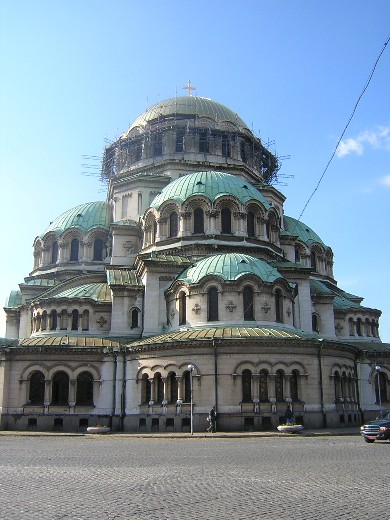
The Aleksandar Nevski church stands in the middle of a large cobbled square, which is in turn surrounded by a park. To the west of he church you’ll usually find an impressive antique market (it seems to be busiest on a Saturday). You’ll find all kinds of stuff here, from Roman coins through to Soviet memorabilia. Try to time your visit so that you aren’t here when all the all traders are off on holiday enjoying the profits from the unspeakable tat that they’ve managed to sell to the Scotsman at vastly inflated prices.
Just to the north of this market (between Oborishte and Moskovska) is the Church of Sveta Sofia, after which the city is named. This brown brick building is reckoned to the second oldest in the city, after St George’s Rotunda. The church dates from the 6th century although it has been restored a few times since (during Ottoman rule it was used as a mosque; conveniently the minarets fell down during an earthquake). The relatively plain brick interior makes a pleasant contrast to the over-the-top frescoes in some of Sofia’s other churches, and there's an interesting display of old pictures and photos showing what the church used to look like (it has only just been comprehensively restored). Next to the south wall of the church is the Tomb of the Unknown Soldier, flanked by a couple of bronze lions.
MOUNT VITOSHA
Mount Vitosha (which stands just under 2300 metres above see level) dominates the sky-line to the south of the city. The mountain, and the national park that surrounds it, is easily accessible from the city centre, and is a popular destination for a day out with residents of Sofia . In summer you'll see walkers, mountain bikers and paragliders, in winter there are ski runs on the mountain. It's a great place to go if you want to get away from the city centre for a while, take in some fresh air, or just enjoy the spectacular views. It's possible to get quite high up the mountain (in fact all the way up to the top) with remarkably little effort. To get right to the top you can take the cable car from the village of Simeonovo, which can either be reached from the city centre by bus or much more easily by taxi. The manly way to do it though is to go the village of Dragalevtsi (again you can do it by bus, but a taxi is cheap enough and much easier) and take the chair lift, which is a 40 minute ride (you have to change half way up) and leaves you open to the elements dangling in mid air with only a flimsy barrier between you and certain death (or a nastily twisted ankle, at the very least). Hopping on and off the chair lift (it doesn't stop for you) is much more fun too.
Then again, if you go back in February, like we did, it might just be a bit nippy to go up on the chair lift, and the Simeonovo cable car might look like a more attractive proposition. The ride takes about 40 minutes and the scenery is stunning (although the chair lift probably offers better views of Sofia itself). By the way, the cable cars themselves are described as being built for 8 people, which I would say is rather on the optimistic side
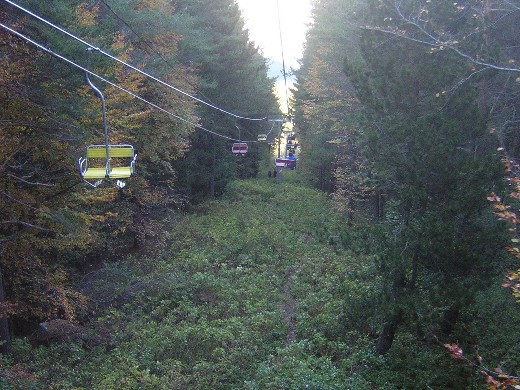
A one way ride on the chair lift will set you back all of 1.2 leva (about 50p). The only problem with the chair lift is that it doesn't take you all the way to the top of the mountain, it drops you off (not literally, I hope) at Goli Vrah, over 400 metres below the highest peak. It's a reasonably easy climb from here to the top of the mountain, i.e. there are no cliffs or anything, you just follow a path, but needless to say we didn't try it. We did end up walking around for a good few hours though, and the good thing about Mount Vitosha is that even on a weekend when Sofians come here in their thousands it's so damned big that you can walk for hours and not see another person. Of course that wouldn't be a good thing if you get lost...
A word of caution, this is a high mountain, and the weather can quickly turn the worse, even in the summer, so it's a good idea to go up there prepared, a compass and a bar of Kendal mint cake, that kind of thing. You should certainly be more prepared than the Scotsman and I, who had half a bottle of Fanta and a small bag of almonds between us which just goes to prove that we weren't in the boy scouts (although I understand that the Scotsman does hang around outside girl guide huts quite a lot....). And it was even worse when we went up again in August; we were enjoying a lovely sunny day when out of nowhere came a rumble of thunder and within 10 minutes the sky was full of dark clouds. We managed to avoid the worst of the storm on the mountain but then we actually had to pass through it when we came down on the chairlift, with lightning crackling around us and rain so hard that it was like being in a shower (an experience alien to me ape-like companion, which may have explained the rather tense look on his face). Great fun!
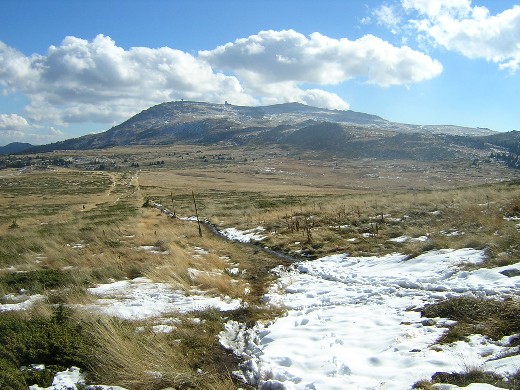
And if you're there in winter, keep a wary eye out for skiers who come hurtling past at break-neck speeds, and the occasional lost eskimo, like this one....
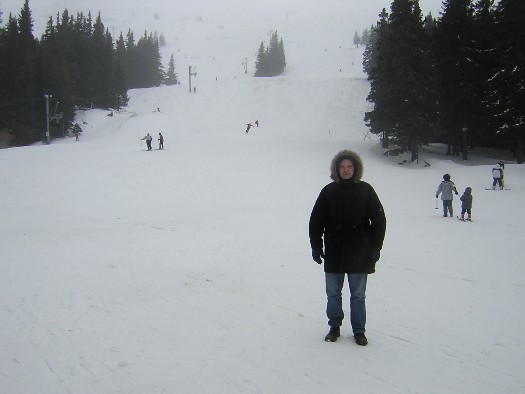
Anyway, it's worth the effort because the views of Sofia, the Sofia valley, and the Rila Mountains to the south are absolutely breathtaking.
( This page sometimes takes a long time to load; if by the time it's finished loading some of the photos are missing try right-clicking over them and pressing "Show Picture" and they should appear. If that doesn't work, try visiting the mirror site for this page : http://www.stemcvee.supanet.com/sofia.htm )